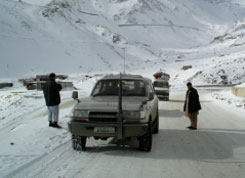The Ties that Bind
Mexican immigrants to the U.S. often join together to send money back home, a practice that’s affecting local politics there
By Marjorie Howard
For Mexican migrants living in the United States, the pull of their hometowns is strong. But it’s not just the flavor of pico de gallo or the sound of a brass band that ties them to the villages they left behind. Many migrants work two or three low-paying jobs and live in overcrowded apartments so they can send half of their earnings back home.

“The question is, do these partnerships between transnational migrant associations and local governments have any effect on how the government behaves?” asks Katrina Burgess. Photo: Alonso Nichols
In Mexico, those funds not only go to workers’ families, they also help pay for community development in their hometowns. The remittances add up: they are second only to foreign direct investments, says Katrina Burgess, an associate professor of international political economy at the Fletcher School.
To ease their transition to life in a new country, Mexican immigrants from the same villages often gather to play soccer and socialize. Some of the groups evolve into hometown associations, which help address problems in their home communities. Perhaps the local church needs repairs or a road has to be fixed; maybe earthquake victims are in need of money, or a village needs a new well.
The projects funded by hometown associations used to be done on an informal basis. Now, Burgess says, some associations are forming partnerships with local governments and co-financing projects.
In her research on U.S.-based migrant associations and their impact, Burgess focuses on “the interaction between the state and these immigrant groups and how it is negotiated. The question is,” she says, “do these partnerships between transnational migrant associations and local governments have any effect on how the government behaves? Is the association more likely to insist on transparency and monitor how well the project is being done?”
Tracking Progress
In fact, immigrants take credit for a Mexican matching grant program known as 3 for 1. For every peso committed by a hometown association, the local government pitches in one peso, the state a second and the Mexican government a third, formalizing the transnational, public-private partnership, Burgess says.
The U.S.-based hometown associations have several ways of tracking the projects they contribute to. “Often someone in the community will send videos or pictures or call on the phone,” says Burgess. “Some communities barely have electricity but have access to an Internet café. If you have an active hometown association that is sufficiently well off, the leader might make regular trips to the town and check things out and meet with the mayor.”
Not everyone is appreciative. Some of those who stay behind are critical of hometown association projects, arguing that they only beautify the town so when immigrants return, there are paved roads for their pickup trucks and nice plazas for their festivities. “Others say it’s genuinely philanthropic and the associations get satisfaction out of contributing to the betterment of their communities,” says Burgess. “Probably some of both is going on.”
The associations are often operated by only a few people, but many others make donations or buy raffle tickets or spend money at association-sponsored events. To some extent, says Burgess, these gatherings also engage young people in their Mexican culture. At association events in the United States, young people listen to the music, eat the food and see the costumes of their native villages.
Burgess, who has conducted extensive research on the effect of hometown associations in Mexico and El Salvador, notes that there is also an increasing recognition of how important migrants in the U.S. are to the development of communities in those nations. “Remittances are a hot topic for developing country governments,” she says.
The Mexican government, meanwhile, is concerned that recent U.S. restrictions on immigration, which make travel back and forth more difficult, will mean fewer migrants will maintain close ties to home. Not only could funding for local projects decrease, but cultural connections might be severed as well.
Burgess says a large percentage of migrants have every intention of eventually returning to their villages to live, and during the recent economic downturn a significant number did go back. But the larger reality is that many tend to stay in the U.S. “This is made even more the case by our increasingly restrictive immigration environment,” she notes.
All of this translates into a shift in resources, something that concerns the Mexican government, Burgess says. “The government is putting a lot of energy into trying to strengthen the cultural and social ties between the second-generation immigrants and their hometowns.”
Marjorie Howard can be reached at marjorie.howard@tufts.edu.

